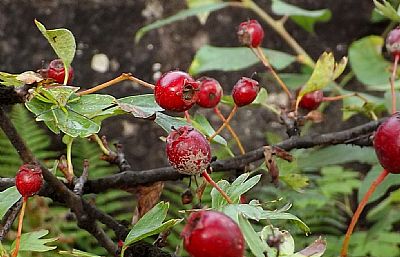HAWTHORN
Everyone recognises hawthorn. The local species that you are most likely to find in West Dunbartonshire is common hawthorn. It has white flowers which make quite a show around May and into the summer. But another species is also found here. This is the Midland hawthorn. They are very similar to each other, but do have some telling differences.
You will frequently find pink hawthorn. Quite what you are looking at can be uncertain. The Woodland Trust tells us that hawthorns are hermaphrodite, meaning both male and female reproductive parts are contained within each flower. Flowers are highly scented, white or occasionally pink with five petals, and grow in flat-topped clusters. But you could be seeing a hybrid through cross fertilisation. Below is an attempt to clarify.
And just to confuse you, the blackthorn shares some characteristics with them too.
COMMON HAWTHORN : Cratagaegus monogyna
The native species is more properly called common hawthorn. It is the prickly essence of almost all our roadside hedges and many an independent tree. It flowers in May with masses of creamy-white blossoms colouring much of the rural landscape. Many refer to it as the May Tree because of the grand show at that time of year. Technically though it is a shrub. (A tree has a single trunk. Shrubs have several stems).
The very fact that it is almost impenetrable to larger animals meants that it provides a safe haven for smaller ones from hedgehogs to birds. Shield bugs and yellowhammers that feed on the haws, to wood mice and slow worms that shelter in the thorny thickets.
The hawthorn that we find in West Dunbartonshire is usually common. hawthorn. Common hawthorn has shiny leaves, divided into three to seven pairs of lobes, and five-petalled, sweet-smelling flowers. It can be distinguished from the similar midland hawthorn by its more deeply lobed leaves and the fact that it only has a single seed in each fruit.
Sometimes you may see a hawthorn with pink tp dark reddish flowers - these may be hybrid but are more likely the Midland hawthorn desribed next.
Hawthorn berries can be used to make jellies, syrups and relishes. Evin gin. You can find recipes online. There are even health benefits of taking hawthorn and it is considered a medicinal herb. BUT as with so many plants, correct preparation is essential or you could suffer bad side effects.

Fresh growth on a hawthorn hedge above Renton.

In early May small buds start to appear.

It is not long before the buds open.

Mid May and the flowers are dazzling.

A pink hawthorn on the Leven towpath in June. But is it a hybrid common hawthorn or simply an exceptionally pink one - or perhaps an example of the type described below.

Hawthorn berries in August. These are edible. But don't confuse any other red berries that may be growing alongside these. Those could be toxic. index.asp?pageid=732976

Don't you just love that tidy folded back colar with a hint at the flower it formed from.

They appear in profusion into September and beyond.

Looking festive by late September / early October.
MIDLAND HAWTHORN : Crataegus laevigata
It is also known as the woodland hawthorn, English hawthorn, mayflower or smooth hawthorn.
The Woodland Trust describes the Midland as dense and pungent, but with fruits that are enjoyed by birds and humans alike,. The Midland hawthorn is a supremely useful tree whose natural range is not fully understood.
It is very difficult to tell it apart from the common hawthorn. The flowers are usually white, but unlike the former, pink flowers, some almost red, are also found.

Two hawthorns grow together. Their leaves and branches are extremely similar, but the flowers contrast,

The pink flowers of the Midland hawthorn are very similar to those of the common hawthorn, but tend to open more slowly and can range from white to pink to almost red.
Telling the difference from blackthorn.
Hawthorn can be also be confused with blackthorn. Also see : index.asp?pageid=731579 The Woodland Trust explains :
Blackthorn blossoms before its leaves start to show, whereas hawthorn flowers after its leaves have emerged. This is one of the best tips for identifying the two species in spring.
Blackthorn usually flowers first, from around March to June.
Hawthorn flowers from around April to June.
Hawthorn petals are rounded and fuller than those of blackthorn.
Hawthorns are hermaphrodite, meaning both male and female reproductive parts are contained within each flower. Flowers are highly scented, white or occasionally pink with five petals, and grow in flat-topped clusters.
Hawthorn berries are red. Blackthorn berries are blue-black.
EATWEEDS : https://www.eatweeds.co.uk/hawthorn-crataegus-monogyna#food_uses_of_hawthorn
HEALTHLINE : https://www.healthline.com/nutrition/hawthorn-berry-benefits
NATURE WORD : https://www.natureword.com/hawthorn-side-effects-risks-and-contraindications/
SCOTTISH WILDLIFE TRUST : https://scottishwildlifetrust.org.uk/species/common-hawthorn/
WEB MD : https://www.webmd.com/vitamins-and-supplements/hawthorn-uses-and-risks
WIKI[EDIA : https://en.wikipedia.org/wiki/Crataegus
WOODLAND TRUST : https://www.woodlandtrust.org.uk/trees-woods-and-wildlife/british-trees/a-z-of-british-trees/hawthorn/

